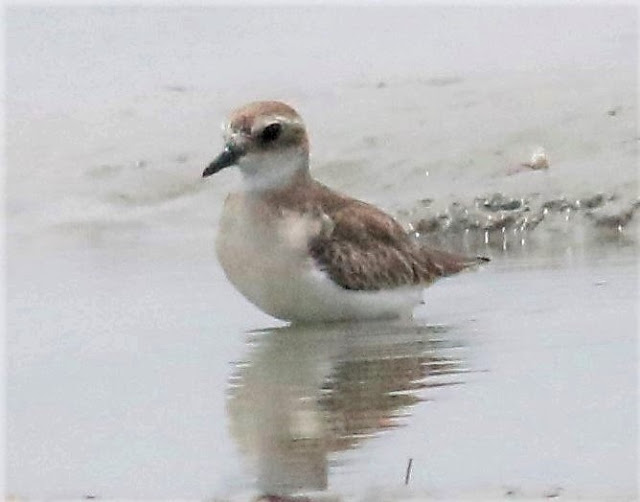From June to August this year, I have been surveying the various shorebirds in the western coast of Peninsular Malaysia. I thought a break would be nice but when opportunity came knocking, there is no time to waste. This time the location of survey was along the coastline of Kuala Selangor.
Waiting for the tide to recede
As the tide receded further, the first batch of birds came. These were mainly small 'Calidris' and 'Charadrius' which can be seen at the right side of the photo.
No waders yet but the tide has already more than half way down. Wonder where have they all gone to?
Finally they came in numbers. They were all scattered along the mudflats and not concentrated like those in TAT or Kuala Muda sites. The length of coastline between Kuala Selangor to Klang is about 43km or 27 miles. So I guess they could be anywhere along this coastline.
Here you could see a variety of shorebirds, foraging harmoniously along each other. I guess there are enough food for all at this place. Most of them stayed quite a distance from where we are though.
Nevertheless I did managed to get some decent shots from this trip as well.
Here is a juvenile Lesser Sand Plover showing its typical peech-coloured plumage as described by many literatures. Since its a juvenile, this bird is most likely from the far flung/remote areas of the Far East and not an over-staying individual.
A Lesser Sand Plover - showing new feathers at its scapular area. Most likely a Tibetan race, transiting from breeding to non-breeding plumage.
Another fine looking adult Lesser Sand Plover and a crabby !
Some of them have molted into their winter plumage like this one here.
A comparison of a juvenile Lesser Sand Plover (right) and an adult (left).
Charadrius species of waders are small but they can fly very fast. Not an easy subject for a 'Bird-in-Flight' (BiF) shot.
At times skirmishes can and do happened on mudflats
Here you can see a Lesser Sand Plover approaching another Lesser Sand Plover
Then they started discussing on something.
The one on the left is raising its body to show that it is larger and stronger.
...and suddenly all hell broke loose between them! (note: the victor is the one at the bottom which stood its ground)
Here is an adult Terek Sandpiper. The dark coloured bill and black carpal bar are indicative signs of a breeding Terek SP as described by some books.
When watching waders, it is not easy to get a lifer / a rare bird. But as a consolation, when one sees a bird with a flag or ring, it can be considered an eureka !
The bird on the right spots a "Blue over Yellow" flag. According to the flagging protocol, this Terek Sandpiper has been banded in Bohai Bay, China which is one of the most strategic and important rest area for Artic birds migrating along the EAAF routes.
A close-up on the flags.
A Terek Sandpiper trying to find a spot to land on a 'hostile' land.
I have yet to see a "Little Stint" but this Red-necked Stint provides a cool relief.
A comparison of a Red-necked Stint in post breeding plumage (2 cy) and another in winter plumage.
Possibly another wader from the Far East example Siberia. This is a juvenile Curlew Sandpiper.
In this trip we saw quite a number of Eurasian Curlews and Common Redshanks too.
This is an Eurasian Curlew showing its clean white underwings, long bill and wing span.
This Eurasian Curlew, however, has a shorter bill.
While this Eurasian Curlew has a shorter wing. Three different profile/variations of a same species.
A Common Redshank flying in
This photo has a lot of "noise" but I think it is still pretty decent though.
A much sharper photo of a Common Redshank
This is more like a common looking Common Redshank.
There were also terns and other interesting shore birds sighted in this trip too.
Common Tern
Unlike the Ssp S.h Longipennis (photo below) which has a dark bill and black legs, this is the Ssp S.h minussensis which shows a red bill with black tip and red colored legs (Allen J & Alan Pearson, 2012). These features are only distinguishable during breeding season. Note also its pinkish belly !
A Common Tern (Ssp S.h Longipennis)
Whiskered Tern
Showing its smudgy looking under belly
Along with "Little Terns", these Whiskered Terns are gregarious birds which like to follow fishermen boats for an easy pick of fishes.
These are Black-winged Stilt which hardly forage in intertidal flats. Seen here for the first time. Local fishermen were equally astonished with their presence.
Love how Dr. Wells described their leg color as putty-pink.
As mentioned earlier, nature can be very unpredictable and hostile if you are not careful.
Here are two mudskippers casually chatting away and seemingly unaware what is coming their way for one of them.
Then out of no where, a Little Egret swooped in to take one of them. Gone in just a few minutes. Nature can be unforgiving at times.
This Grey Heron brought some cheers to the proceedings.
It can be found from the Americas to Europe and right down to India, South East Asia to China and Japan. Truly an international bird.
Another majestic and iconic bird at this place.
Lesser Adjutant aka 'Burung Botak'
Painted Stork
This time we saw 60 of them foraging near the jetty.
THE END !
"The person who starts the story has to finish the story"
(Jose Mourinho, 2013)































































